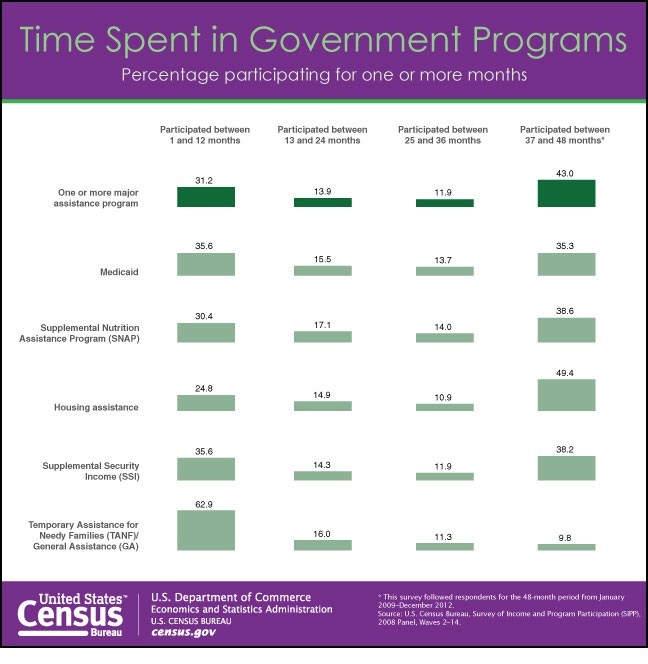
|
|

|
|
| April 27, 2024 |
|
21.3% of US participates in government assistance programs each month 
Approximately 52.2 million (or 21.3 percent) people in the U.S. participated in major means-tested government assistance programs each month in 2012, according to a U.S. Census Bureau report released Thursday. Participation rates were highest for Medicaid (15.3 percent) and the Supplemental Nutrition Assistance Program, formerly known as the food stamp program (13.4 percent).
The average monthly participation rate in major means-tested programs increased from 18.6 percent in 2009 to 20.9 percent in 2011. However, from 2011 to 2012, there was no statistically significant change in the percentage of people who participated. From 2009 to 2012, the average monthly participation rates for Medicaid, Supplemental Security Income and SNAP increased, while the rate decreased for Temporary Assistance for Needy Families/General Assistance. The largest share of participants (43.0 percent) in any of the public assistance programs stayed in the programs between 37 and 48 months. Additionally, 31.2 percent of people participated between one and 12 months between January 2009 and December 2012. How Long Did People Participate in Programs? • Of people enrolled in Medicaid, 35.6 percent participated between one and 12 months and 35.3 percent participated between 37 and 48 months. • At 38.6 percent, the largest share of SNAP recipients participated between 37 and 48 months. • At 49.4 percent, the largest share of people receiving housing assistance benefits participated between 37 and 48 months. • Of people enrolled in the Supplemental Security Income program, 35.6 percent participated between one and 12 months, while 38.2 percent participated between 37 and 48 months. • At 62.9 percent, the largest share of people participating in TANF participated between one and 12 months. Who Participated in 2012? • Children under age 18: Those under 18 were more likely to receive means-tested benefits than all other age groups. o In an average month, 39.2 percent of children received some type of means-tested benefit, compared with 16.6 percent of people age 18 to 64 and 12.6 percent of people 65 and older. • The black population: At 41.6 percent, blacks were more likely to participate in government assistance programs in an average month. o The black participation rate was followed by Hispanics at 36.4 percent, Asians or Pacific Islanders at 17.8 percent, and non-Hispanic whites at 13.2 percent. • Female-householder families: At 50 percent, people in female-householder families had the highest rates of participation in major means-tested programs. o The rates for people in married-couple families and male-householder families were 14.7 percent and 29.5 percent, respectively. • Non-high school graduates: 37.3 percent of people who did not graduate from high school received means-tested benefits. o 21.6 percent of high school graduates and 9.6 percent of individuals with one or more years of college participated in one of the major means-tested government assistance programs. • The unemployed: In an average month, 33.5 percent of the unemployed received means-tested benefits in an average month of 2012. o By comparison, 25.3 percent of those not in the labor force, 17.6 percent of part-time workers, and 6.7 percent of full-time workers participated in means-tested programs. (INT) Story Date: May 29, 2015
|